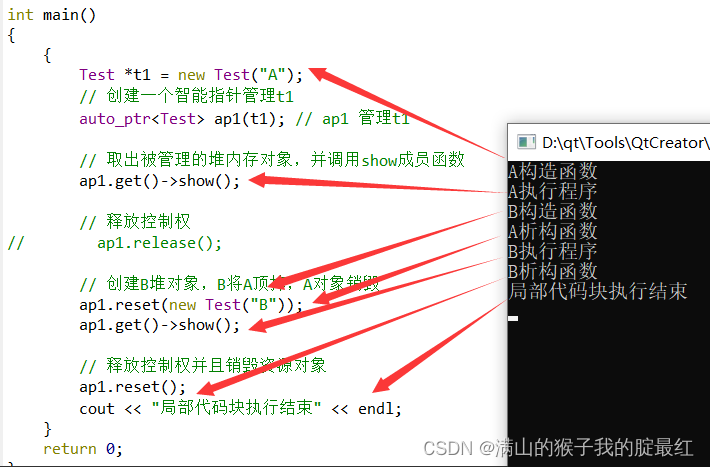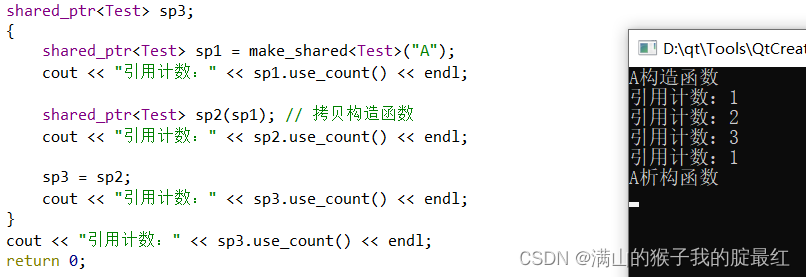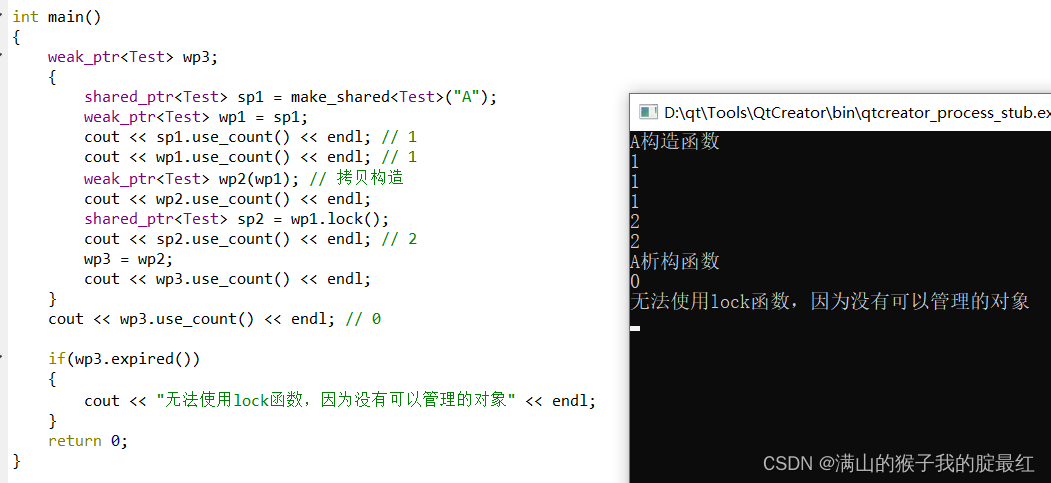c++-智能指针
1、概念
堆内存的对象需要手动使用delete销毁,如果忘记使用delete销毁就会造成内存泄漏。
所以C++在ISO?98标注中引入了智能指针的概念,并在C++11?中趋于完善。
使用智能指针可以让堆内存对象具有栈内存对象的特性。原理时给需要自动回收的堆内存对象套上一层栈内存的模板类对象即可。

C++有四种智能指针:
- auto_ptr?(自动指针,已经废弃)(C++ISO?98)
- unique_ptr?(唯一指针)(C++ISO?11)
- shared_ptr?(共享指针)(C++ISO?11)
- weak_ptr?(协助指针)(C++ISO?11)
使用智能指针需要引入头文件#include<memory>
2、auto_ptr
#include?<iostream>
#include?<memory>
using?namespace?std;
class?Test
{
private:
????string?s;
public:
????Test(string?s):s(s)
????{
????????cout?<<?s?<<?"构造函数"?<<?endl;
????}
????~Test()
????{
????????cout?<<?s?<<?"析构函数"?<<?endl;
????}
????void?show()
????{
????????cout?<<?s?<<?"执行程序"?<<?endl;
????}
};
int?main()
{
????{
????????Test?*t1?=?new?Test("A");
????????//?创建一个智能指针管理t1
????????auto_ptr<Test>?ap1(t1);?//?ap1?管理t1
????????//?取出被管理的堆内存对象,并调用show成员函数
????????ap1.get()->show();
????????//?释放控制权
//????????ap1.release();
????????//?创建B堆对象,B将A顶掉,A对象销毁
????????ap1.reset(new?Test("B"));
????????ap1.get()->show();
????????//?释放控制权并且销毁资源对象
????????ap1.reset();
????????cout?<<?"局部代码块执行结束"?<<?endl;
????}
????return?0;
}

释放对象不会调用析构函数,只有销毁对象才会有

由于成员变量存在指针类型,因此拷贝构造函数与赋值运算符的使用会出现问题。与浅拷贝的问题不同的是,auto_ptr的复制语义会引起资源对象控制权转移的问题。
#include?<iostream>
#include?<memory>
using?namespace?std;
class?Test
{
private:
????string?s;
public:
????Test(string?s):s(s)
????{
????????cout?<<?s?<<?"构造函数"?<<?endl;
????}
????~Test()
????{
????????cout?<<?s?<<?"析构函数"?<<?endl;
????}
????void?show()
????{
????????cout?<<?s?<<?"执行程序"?<<?endl;
????}
};
int?main()
{
????{
????????Test?*t1?=?new?Test("A");
????????//?创建一个智能指针管理t1
????????auto_ptr<Test>?ap1(t1);?//?ap1?管理t1
????????auto_ptr<Test>?ap2(ap1);????//?显式调用拷贝构造函数
????????cout?<<?ap1.get()?<<?"?"?<<?ap2.get()?<<?endl;?//?0?0x1052780
????????auto_ptr<Test>?ap3?=?ap2;???//?隐式调用构造函数
????????//?0?0?0xe82780
????????cout?<<?ap1.get()?<<?"?"?<<?ap2.get()?<<?"?"?<<?ap3.get()?<<?endl;
????????auto_ptr<Test>?ap4;
????????ap4?=?ap3;??//?赋值运算符
????????//?0?0?0?0x922780
????????cout?<<?ap1.get()?<<?"?"?<<?ap2.get()?<<
????????????????"?"?<<?ap3.get()?<<?"?"?<<?ap4.get()?<<?endl;
????}
????return?0;
}
3、unique_ptr
作为对auto_ptr的改进,unique_ptr对其他持有的资源对象具有唯一控制权,即不可以通过常规的复制语义转移或拷贝资源对象的控制权。

通过特殊的语法实现控制权的转移效果。
#include?<iostream>
#include?<memory>
using namespace std;
class Test
{
private:
string?s;
public:
Test(string?s):s(s)
{
????????cout?<<?s?<< "构造函数" <<?endl;
}
~Test()
{
????????cout?<<?s?<< "析构函数" <<?endl;
}
void show()
{
????????cout?<<?s?<< "执行程序" <<?endl;
}
};
int main()
{
{
????????Test?*t1?= new Test("A");
//?创建一个智能指针管理t1
unique_ptr<Test> up1(t1); //?up1?管理t1
unique_ptr<Test> up2(move(up1)); //?显式调用拷贝构造函数
????????cout?<<?up1.get() << "?" <<?up2.get() <<?endl; //?0?0x1052780
unique_ptr<Test>?up3?= move(up2); //?隐式调用构造函数
//?0?0?0xe82780
????????cout?<<?up1.get() << "?" <<?up2.get() << "?" <<?up3.get() <<?endl;
unique_ptr<Test>?up4;
????????up4?= move(up3); //?赋值运算符
//?0?0?0?0x922780
????????cout?<<?up1.get() << "?" <<?up2.get() <<
"?" <<?up3.get() << "?" <<?up4.get() <<?endl;
}
return 0;
}

4、shared_ptr
unique_ptr对资源具有独占性,多个shared_ptr对象可以共享资源。
shared_ptr有两种创建方式:

两种创建方式的区别在于后者是一步到位(创建资源对象+关系绑定),前者分为两步完成(先创建资源对象,再进行关系绑定)。
新方式的优点:
- 安全性更好
- 性能更好
新方式的缺点:
- 资源释放效率低
每多一个shared_ptr对资源进行管理,引用计数将+1,每个指向该对象的shared_ptr对象销毁时,引用计数-1,最后一个shared_ptr对象销毁时,计数清零,资源对象销毁。
#include?<iostream>
#include?<memory>
using namespace std;
class Test
{
private:
string?s;
public:
Test(string?s):s(s)
{
????????cout?<<?s?<< "构造函数" <<?endl;
}
~Test()
{
????????cout?<<?s?<< "析构函数" <<?endl;
}
void show()
{
????????cout?<<?s?<< "执行程序" <<?endl;
}
};
int main()
{
shared_ptr<Test>?sp3;
{
shared_ptr<Test>?sp1?= make_shared<Test>("A");
????????cout?<< "引用计数:" <<?sp1.use_count() <<?endl;
shared_ptr<Test> sp2(sp1); //?拷贝构造函数
????????cout?<< "引用计数:" <<?sp2.use_count() <<?endl;
????????sp3?=?sp2;
????????cout?<< "引用计数:" <<?sp3.use_count() <<?endl;
}
????cout?<< "引用计数:" <<?sp3.use_count() <<?endl;
return 0;
}

5、weak_ptr
weak_ptr是一个不控制资源对象的智能指针,也不会影响资源的引用计数,其主要目的是协助shared_ptr工作。
通过weak_ptr的构造函数,参数传入一个持有资源对象的shared_ptr对象或者weak_ptr对象即可创建。
weak_ptr与资源对象呈现弱相关性,所以不支持get等函数直接操作资源对象。
建议weak_ptr调用lock函数之前,先检测引用计数是否大于0,或使用expried()函数检测是否可以转换为shared_ptr。
lock()函数,通过传入持有资源对象的对象创建新对象
#include?<iostream>
#include?<memory>
using namespace std;
class Test
{
private:
string?s;
public:
Test(string?s):s(s)
{
????????cout?<<?s?<< "构造函数" <<?endl;
}
~Test()
{
????????cout?<<?s?<< "析构函数" <<?endl;
}
void show()
{
????????cout?<<?s?<< "执行程序" <<?endl;
}
};
int main()
{
weak_ptr<Test>?wp3;
{
shared_ptr<Test>?sp1?= make_shared<Test>("A");
weak_ptr<Test>?wp1?=?sp1;
????????cout?<<?sp1.use_count() <<?endl; //?1
????????cout?<<?wp1.use_count() <<?endl; //?1
weak_ptr<Test> wp2(wp1); //?拷贝构造
????????cout?<<?wp2.use_count() <<?endl;
shared_ptr<Test>?sp2?=?wp1.lock();
????????cout?<<?sp2.use_count() <<?endl; //?2
????????wp3?=?wp2;
????????cout?<<?wp3.use_count() <<?endl;
}
????cout?<<?wp3.use_count() <<?endl; //?0
if(wp3.expired())
{
????????cout?<< "无法使用lock函数,因为没有可以管理的对象" <<?endl;
}
return 0;
}

本文来自互联网用户投稿,该文观点仅代表作者本人,不代表本站立场。本站仅提供信息存储空间服务,不拥有所有权,不承担相关法律责任。 如若内容造成侵权/违法违规/事实不符,请联系我的编程经验分享网邮箱:chenni525@qq.com进行投诉反馈,一经查实,立即删除!
- Python教程
- 深入理解 MySQL 中的 HAVING 关键字和聚合函数
- Qt之QChar编码(1)
- MyBatis入门基础篇
- 用Python脚本实现FFmpeg批量转换
- 七麦数据js逆向(扣代码版)
- FPGA未解之谜
- 如何使用WinDiff浏览和对比Windows源代码中的符号和系统调用信息
- Netty-2-数据编解码
- 【论文阅读+复现】SparseCtrl: Adding Sparse Controls to Text-to-Video Diffusion Models
- 【电机控制】PMSM无感foc控制(八)锁相环(PLL)的应用
- MySQL的事务以及springboot中如何使用事务
- Linux系统SSH远程管理服务概述
- 【2024最新-python3小白零基础入门】No4.python控制语句学习
- PulseGAN